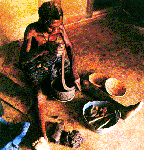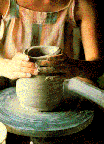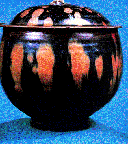

 Coiled
forms were built up from long rolls of clay, and then smoothed with the fingers
or a smooth piece of wood or stone.This link will show you
how coiled construction is done .
Coiled
forms were built up from long rolls of clay, and then smoothed with the fingers
or a smooth piece of wood or stone.This link will show you
how coiled construction is done .
 Slab
construction involves rolling out a flat sheet of clay, cutting shapes from
the sheet, and assembling them into the desired forms. All of these ancient
methods are still practiced by craftspersons around the world. This link will show you
how slab construction is done .
Slab
construction involves rolling out a flat sheet of clay, cutting shapes from
the sheet, and assembling them into the desired forms. All of these ancient
methods are still practiced by craftspersons around the world. This link will show you
how slab construction is done .
 Wheel
throwing to make clay objects was developed in China at least as early
as 3500 BC. This involves centering a ball of clay on a table that is turned
by kicking a weighted wheel, or operating a treadle. The form is shaped by the
potters hands, but is perfectly symmetrical, because of the turning of the wheel
as he shapes the clay. The potters wheel and the wood lathe in fact operate
on the same principal. Throwing is the method most commonly used today for handmade
ceramics. This link shows the wheel throwing process .
Wheel
throwing to make clay objects was developed in China at least as early
as 3500 BC. This involves centering a ball of clay on a table that is turned
by kicking a weighted wheel, or operating a treadle. The form is shaped by the
potters hands, but is perfectly symmetrical, because of the turning of the wheel
as he shapes the clay. The potters wheel and the wood lathe in fact operate
on the same principal. Throwing is the method most commonly used today for handmade
ceramics. This link shows the wheel throwing process .
The earliest clay objects were earthenware-- that is, hardened in an
open fire. This "low fire" method results in a porous, relatively soft
material, which is not waterproof.
The next stage of development was the invention of the kiln-- a type of oven in which temperatures much higher than an open fire can be obtained. This "high fire" method produces a type of ceramic known as stoneware, which is also opaque, but much harder and stronger than earthenware, and also waterproof, even when unglazed.
 Porcelain
is considered to be the finest quality of ceramics. It is translucent, self
glazing, white, and very hard. Porcelain was developed in China, and is made
of a special type of clay called kaolin, plus feldspar. The secret of porcelain
was not discovered in Europe until the early 18th century, when the first porcelain
factory was established at Meissen, in Saxony (now Germany).
Porcelain
is considered to be the finest quality of ceramics. It is translucent, self
glazing, white, and very hard. Porcelain was developed in China, and is made
of a special type of clay called kaolin, plus feldspar. The secret of porcelain
was not discovered in Europe until the early 18th century, when the first porcelain
factory was established at Meissen, in Saxony (now Germany).
 In
mass production of ceramics,
slip casting, is commonly used.
Clay is reduced to a liquid, or slip, by the addition of water. the slip is
then poured into a mold. Jolleying is a mechanical method of
turning a ball of clay, using a mechanical device to force the clay into a mold
while being turned.
In
mass production of ceramics,
slip casting, is commonly used.
Clay is reduced to a liquid, or slip, by the addition of water. the slip is
then poured into a mold. Jolleying is a mechanical method of
turning a ball of clay, using a mechanical device to force the clay into a mold
while being turned.
 The
Surface decoration of ceramics began with simply burnishing
or polishing the surface of the raw clay with a smooth tool. The surface could
also be carved or incised to create decorative patterns or images. Later, designs
were painted on the surface, using clay-like pigments known as slip
that could be fired onto the surface for permanence. By the 14th century, glazes
came into use. Glazes were glass-like mixtures of minerals and silica that produced
a glossy, hard finish when fired. Glazes come in many colors, and could be applied
by dipping or painting to achieve a variety of decorative effects. Some of the
brightest colors used in the past came from materials now known to be harmful:
lead glazes were particularly common in colorful painted folk
pottery, notably from Mexico and Italy; uranium was also used to produce a vivid
orange glaze on tableware until the 1950's. Article with such glazes should
not be used for eating on a regular basis.
The
Surface decoration of ceramics began with simply burnishing
or polishing the surface of the raw clay with a smooth tool. The surface could
also be carved or incised to create decorative patterns or images. Later, designs
were painted on the surface, using clay-like pigments known as slip
that could be fired onto the surface for permanence. By the 14th century, glazes
came into use. Glazes were glass-like mixtures of minerals and silica that produced
a glossy, hard finish when fired. Glazes come in many colors, and could be applied
by dipping or painting to achieve a variety of decorative effects. Some of the
brightest colors used in the past came from materials now known to be harmful:
lead glazes were particularly common in colorful painted folk
pottery, notably from Mexico and Italy; uranium was also used to produce a vivid
orange glaze on tableware until the 1950's. Article with such glazes should
not be used for eating on a regular basis.
 The
modern handcrafted ceramics movement in the United States and England dates
back to the 1930's and 40's. Bernard Leach was a leading figure in the development
of this modern style, which owes a great deal to the folk ceramic traditions
of Japan and China.
The
modern handcrafted ceramics movement in the United States and England dates
back to the 1930's and 40's. Bernard Leach was a leading figure in the development
of this modern style, which owes a great deal to the folk ceramic traditions
of Japan and China.

|